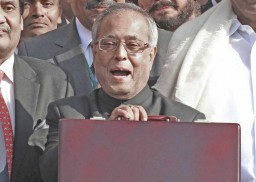
Almost a replay of the last few years, the Finance Minister again failed to deliver anything worthwhile in this year’s budget proposal for the Textile and Apparel Industry. Though the budget outlay for the industry has been raised by 27% to Rs. 7000 crore for FY 2012-13 against revised plan expenditure of Rs. 5503.30 crore in FY 2011-12, the allocated plan outlay of Rs. 2775.80 crore under TUFS for FY 2012-13, is down by 21% on YOY basis.
While appreciating the various progressive measures taken in the Union Budget 2012-13, Chairman AEPC, Dr. A Sakthivel feels that the impact of most of the measures will be very limited, as the textile package has only addressed the handlooms and powerlooms sector and not the larger needs to the industry, especially the credit availability at concessional rates. “Extension of relief for R&D activities and testing laboratories and exemption up to 150% for expenditure on skill development in manufacturing sector as also allocation of Rs. 1000 crore for National Skill Development programmes are steps in the right direction. Apparel industry also welcomes the initiatives for improving infrastructure facilities like roads, ports and ICDs, which have been major bottlenecks for exports,” says Sakthivel.
[bleft]Proposals with positive impact on the industry
Reduction in basic customs duty from 5% to zero% on new automatic shuttle-less looms and select processing machines would substantially reduce the capital cost for modernization and enhancing capacity.
The weighted reduction of 200% to 150%, respectively for spending on R&D and skill development initiatives would trigger and incentivize investment and efforts in this direction. [/bleft]
Some of the initiatives that the industry has welcomed include the Rs. 5000 crore allocated for venture capital, exemption of capital gains tax for purchase of new plant and machinery by SMEs and custom duty relief to shuttle-less looms and processing machinery. The extension of concessional rate of custom duty of 5% to new textile machinery is a disappointment. “The industry was expecting zero customs duty for special machineries for manufacturing synthetic garments and processing of fibres, which could have increased our export competitiveness,” says Sakthivel.
The industry has expressed concern on the lack of initiatives to promote the growth of man-made fibres. S Dinakaran, Chairman, SIMA said that the Budget had failed to consider its genuine demands with respect to man-made fibres. He pointed out that the industry has been demanding to abolish 5% customs duty and 4% special additional duty and also bring the central excise duty on par with cotton textiles for the man-made fibre textiles.
CITI had also strongly requested for removal or reduction of excise duty for man-made fibres, yet, the duty has gone up from 10% to 12%. “Though the increase is part of increase in the standard rate itself, it would make the man-made fibres of India less competitive compared to our competing countries,” argued S.V. Arumugam, Chairman, CITI. Referring to the increase of excise duty for man-made fibre-based textile products to 12% and others to 6%, Arumugam stated that the increase may not have a major impact on the industry since the optional route has been continued. However, Sakthivel feels that the increase in standard excise duty rate from 10% to 12% will adversely impact raw material costs.
The increase in service tax will also adversely impact the apparel sector which has high use of services for exports. In fact, the AEPC had recommended exemption of service tax on ECGC premium besides insurance premium paid, bank charges, and some other services essential for exports. Given the increase in number of services to be included in the service tax net and increase in the service tax rate, the Council strongly recommends increasing the service tax refund rate for the apparel sector to 1.5% from the present 0.15%. The industry is worried as they will have higher input tax burden on account of increase in excise duty and service tax by 2%.






